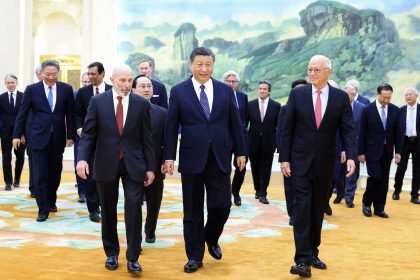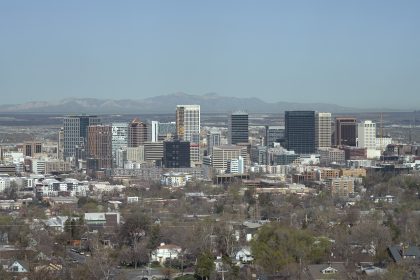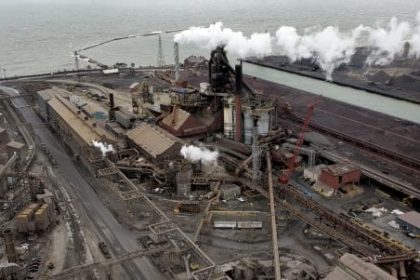At the Doorstep of a Nuclear Energy Revival — Are We Ready?
COMMENTARY | The Ecomodernist

The next several years may determine whether nuclear energy has a future in the United States and, in turn, how successful we will be in reducing our national climate emissions.
There is a broad and growing expert consensus that taking the path of least resistance in the fight against climate change means building lots more clean energy from always-available sources like nuclear, which can complement the sometimes-available energy from solar and wind. Like fossil fuels, nuclear energy can produce power on demand, but without carbon emissions or air pollution.
Nuclear already produces more than half of the clean electricity in the U.S. and has already proven its value for decarbonization in countries like France and Sweden, who have had among the fastest decarbonization rates of any country thanks mostly to their expansion of nuclear energy.
The world has already seen the consequences of taking nuclear plants offline. In both Japan and Germany, reducing nuclear energy meant stalled or reversed climate progress from the fossil energy that predictably replaced it. Just one month ago the last reactor at the Indian Point nuclear power plant in New York was shut down permanently. Despite being promoted as a pathway to more renewables in NY, it too has predictably led to increased fossil fuel use. California is currently in the midst of closing its only remaining nuclear plant at Diablo Canyon, whose clean power will almost certainly be replaced at leat in part by natural gas.
While we could theoretically build more traditional large reactors in the United States, every indication is that we’re unlikely to do so. US developers have struggled to deliver large plants on time and on budget, making it hard for nuclear to compete, especially in unregulated energy markets.
If nuclear energy is going to have a future in the United States, it will most likely be from the cutting-edge nuclear technologies that are nearing commercialization – from startups like Terrapower, Nuscale, and Oklo. Compared to currently operating nuclear reactors, which were developed some 70 years ago, they are designed to be smaller, manufactured en masse in factories, and can run on recycled fuel. Not only are they safer than their predecessors, but their revolutionary safety systems will likely make them the safest form of electricity generation in existence, safer even than solar and wind.
The next several years will be pivotal. If advanced nuclear is to have a bright future, developers need to uphold their end of the bargain and prove they can deliver new plants on time and on budget. But we need to meet them halfway by crafting regulations that make sense for the new designs and by supporting research to accelerate deployment.
Here is how to create the conditions for advanced nuclear to thrive:
First, the pathway to license nuclear reactors needs to be modernized. Congress passed the Nuclear Energy Leadership Act and the Nuclear Energy Innovation and Modernization Act that directs the Nuclear Regulatory Commission (NRC) to develop a new licensing framework for advanced reactor design. The new licensing framework needs to be ready on time for developers to use in 2024. Any delays because appropriations don’t pass on time or the NRC doesn’t have funding to scale its staffing and evaluate multiple advanced reactor licensees would result in crippling increases in project costs.
Second, level the playing field for nuclear by making incentives technology-neutral. Including nuclear in a clean energy standard, hydrogen production R&D programs, or loan guarantee programs, to name a few, allows developers to innovate with the same opportunities as wind or solar. Tax credits, such as investment tax credits and production tax credits, are valuable for reducing investor risk on first-of-a-kind projects.
Third, finish development and launch into deployment. The Department of Energy funds the GAIN voucher program, which leverages expertise at the national laboratories to accelerate research. Many advanced reactor developers are reaching the stage where more funding to programs like GAIN could go a long way to accelerate innovation.
Fourth, the industry needs support to demonstrate new designs. The Department of Energy Advanced Reactor Demonstration Program aims to demonstrate two new designs, from TerraPower and X-Energy, by 2027. Agreements to purchase the power as a direct customer from the first projects (calles PPA’s) are another option to support the first demonstration projects. Other vendors, including NuScale, Oklo, and GE Hitachi, are already at least partially through the licensing process and plan to have reactors operating in the 2020’s.
Fifth, rebuild the capacity to manufacture and recycle nuclear fuel. Advanced reactors use a range of new and improved fuels, but the U.S. doesn’t yet have the capacity to make these fuels at scale. Supporting the expansion of new fuel production can position the U.S. as a world leader in this area, but also provides significant energy security. Advanced reactors also provide a new option — many plan to recycle used fuel from existing reactors as new fuel, dramatically reducing the amount of spent fuel. To do this, new reprocessing facilities need to be supported and approved.
Finally, the Federal government needs to live up to its promise of a long-term storage policy for nuclear waste. This has long been a sticking point for policymakers and anti-nuclear advocates, but it’s important to remember that no other form of energy pays to safely handle and store all of the waste that it produces. The nuclear industry has waited for decades for a long-term solution and several options available, including centralized or decentralized storage facilities, recycling for use in advanced reactors, or formalizing the existing on-site storage. Several states have implemented moratoriums on new nuclear facilities until a long term storage facility is open. When that happens the market for advanced nuclear power in the U.S. will expand significantly.
Advanced nuclear technologies are poised to transform the nuclear industry, but it’s up to policymakers at the NRC and in the federal government to pave the way for the next generation of always-on, clean, and reliable energy.
Adam Stein is the Sr. Nuclear Analyst at the Breakthrough Institute, an environmental research center in Berkeley, California. Follow him on Twitter at @_A_Stein_























